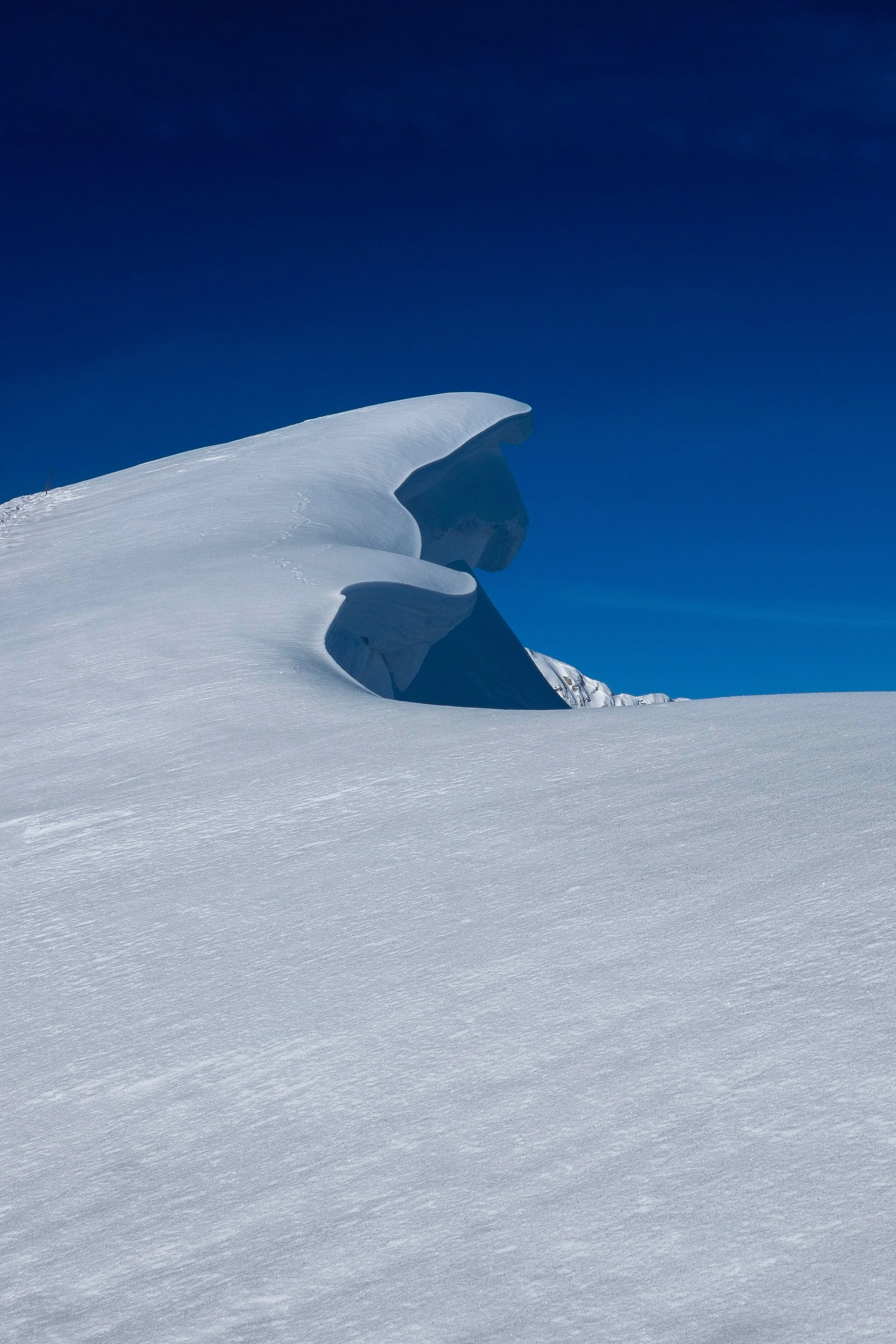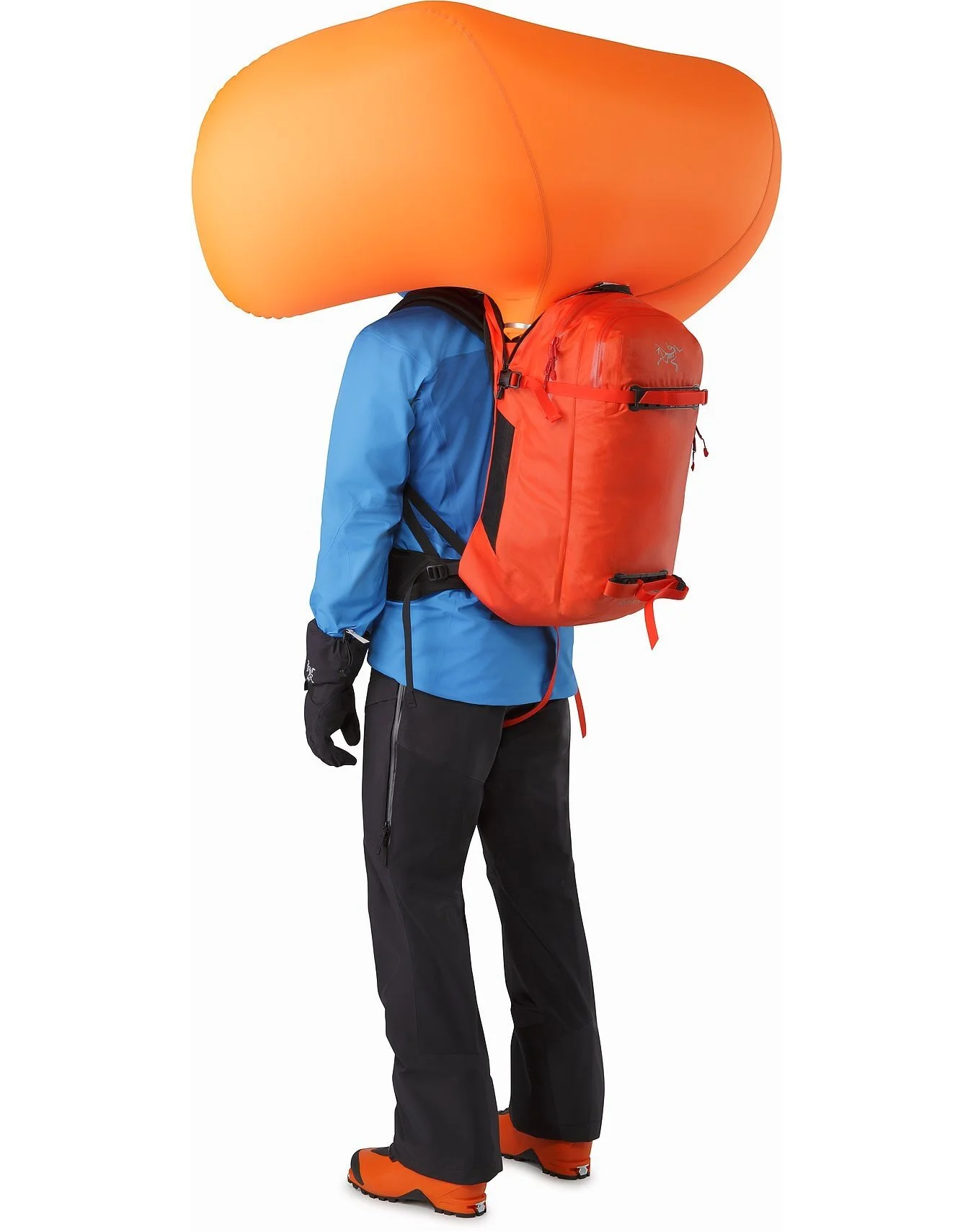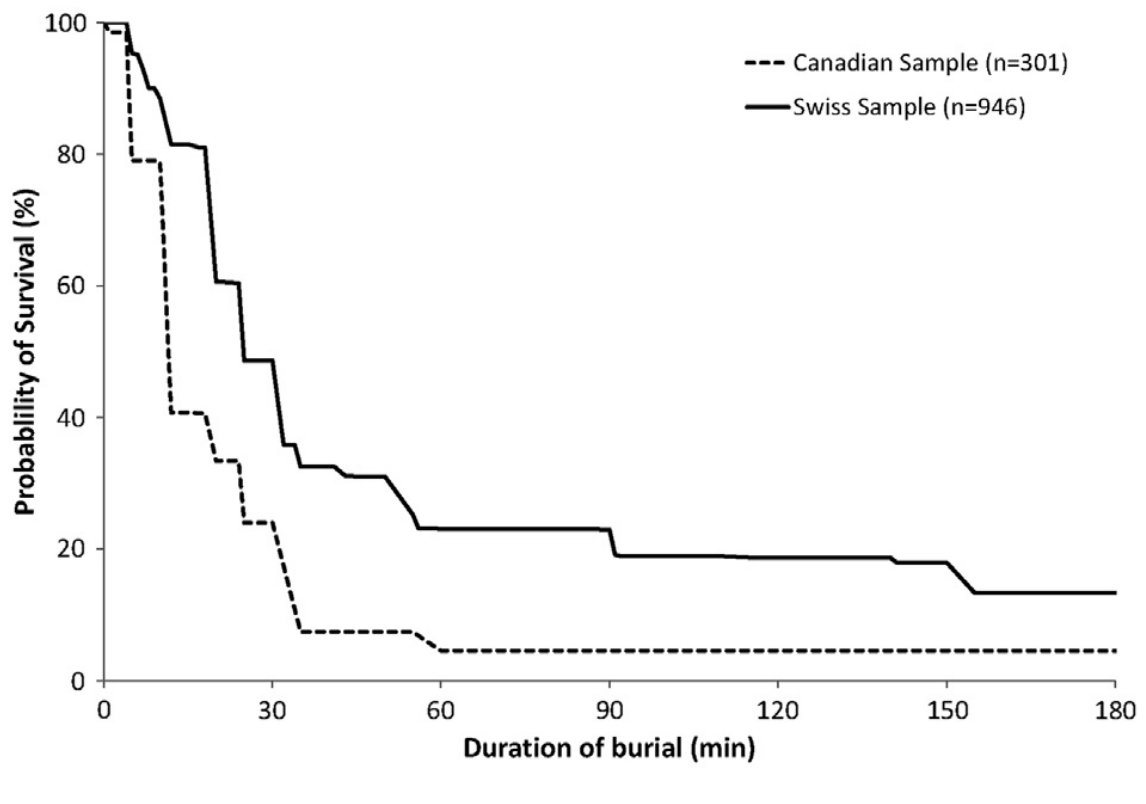Reading Time: 14 minutes
Published: February 16th, 2020
Author: Michael J Buchanan
The Moment of Dread
If your party is a victim of an avalanche, you only have around 10 to 15 minutes to locate the victim before their chance of survival takes a nose dive1,2. This blog will help explain equipment choices for use in avalanche terrain, avoiding a complete burial, avoiding asphyxiation, trauma prevention, and avalanche rescue sequence and equipment. In the first part of this blog post we discussed avalanche prevention as the most important safety factor in traveling in avalanche terrain (click here). In the third (and final) part of this blog series, first aid techniques and equipment will be discussed. It should be noted that this blog does not replace proper avalanche training and practice.
Avoiding Burial: Traveling Safe
A lot have been written about how to avoid being buried in an avalanche. Hypoxia (a condition where the body is deprived of an adequate oxygen supply) can occur in less than 10 minutes of an avalanche burial and asphyxiation can occur within the first 30 to 60 minutes of burial3. Because 75% of avalanche victims die of asphyxiation3,4 burial avoidance techniques can be life or death.
Beyond avoiding avalanche terrain (discusses in the first part of this blog series), there are a few safe travel techniques that can be employed to avoid being buried. These techniques should be employed if you have to travel in potentially high-risk terrain (ie for mountain rescue or avalanche abatement work).
Safe travel techniques are of upmost importance when entering a high-risk avalanche slope. Techniques like crossing a slope one at a time while being watched by your partner, traversing a slope from one island of safety—such as rock outcroppings, heavily forested areas, or lower angle, less than 30º slopes—to another, and planning escape routes if an avalanche occurs are great techniques that employ good group dynamics and situational awareness that was discussed in the first post. Being on a belay (anchored outside of the avalanche terrain) can prevent a potential victim from being swept downhill.
A slope cutting technique—where one traverses quickly across a potentially dangerous slope from one safety zone to another—in an attempt to test a slope has been practiced successfully for a long time. The aim of slope cutting is to test the slope for potential stability—it may even trigger an avalanche rendering the slope safer to navigate5. It should be noted that slope cutting is a potentially dangerous technique and should be avoided by the recreationist.
Be extremely weary of cornices. Always travel on the upwind side of a cornice and travel well away from their edge as cornices often break further back than most people realize. Cornices have been called the “bombs of the backcountry”. A refrigerator sized cornice bouncing down a slope is a very good slope stability test. With the right techniques, a recreationalist can safely kick or saw a cornice onto a slope they intend to ski5. Even if you let loose a cornice, it may be a good idea to dig a pit on the slope below as smaller, lighter cornices may not let loose a large avalanche whose weak layer is deep within the snow pack. A friend of mine was lost to an avalanche for this very reason6.
Avoiding Burial: During an Avalanche
If these avoidance techniques don’t work, and you are caught in an avalanche, there are several things that you should immediately do to increase your likelihood of survival. Before getting onto a potential avalanche slope, zones of safety (such as lower angle flanks) should be identified. Once the recreationist realizes the danger, they should try to move to a zone of safety as quickly as possible. There are a lot of good examples on YouTube (click here) of this technique being used. The idea is that you can use your momentum to ski out of the initial slower moving laminar flow of broken up blocks before you get engulf by the avalanche3,7.
There is ample evidence that fighting for survival if you are caught in an avalanche will save your life. Try to get your feet underneath you and ski out. If you are moving faster and start to get buried, back stroke or log roll to the surface, trying to get to the flank or staying in the starting zone. Any movement of your arms and legs will cause you to move slower than the surrounding moving mass of snow. If you are pushed to the bed of the slope early on, you can try self-arrest techniques to keep you in the starting zone. Another strategy is to try to grab onto any trees that you pass3,7. Although there is some controversy regarding moving during an avalanche8, the benefits seem to outweigh the potential risks3,7,9.
A victim attached to their skis, snowboard, or snowshoes are much more likely to be buried deeper. Any victim should attempt to disengage from their equipment early on. The only thing the victim should keep attached to them is their backpack as it may prevent trauma and you may need packed equipment post-burial9.
Avalanche airbags are backpack systems that deploy a large airbag when the user actuates the system. When caught in an avalanche, the victim activates the system and a large—typically 40 gallon—air bag is released. During an avalanche, larger particles tend to float to the surface, while smaller particles tend to sink7-9. With these airbag systems, once deployed, the victim becomes larger and will float to the top, decreasing the odds of a deep burial3.
Asphyxiation
Approximately 75% of all complete avalanche burial victims (head and torso below snow) will die by asphyxiation3: a condition of insufficient intake of oxygen10 that can cause end organ failure. There are three primary ways by which an avalanche victim can asphyxiate:
- The physical blockage of the upper airway (nose and mouth to the voice box) by snow or debris. This will cause hypoxia (an inadequate supply of oxygen in the blood) in 10 minutes and acute asphyxiation in 30-60 minutes3.
- Ice masks may form. Ice mask formation occurs in non-obstructed airways after burial. Water vapor in the exhaled air of the victim condenses then freezes on the snow in front of the face forming an icy barrier to breathing3.
- Rebreathing exhaled air can also cause asphyxiation. The average oxygen content of the atmosphere is 21% and less than 0.03% carbon dioxide (the rest being nitrogen at 78% and argon at 1%). Expired air contains 16% oxygen and 5% carbon dioxide. Rebreathing expired air results in the gradual decrease in the availability of oxygen and increases the amount of carbon dioxide. Hypoxia and hypercapnia (excess carbon dioxide in the blood) eventually will cause acute asphyxiation3.
Air pocket size is a large factor in determining survivability of victims of complete avalanche burial. The larger the air pocket, the longer an ice mask will take to form, the more oxygen may be available to breath, and the greater the surface area for which carbon dioxide will have to diffuse into the snow pack3.
There are several products specifically made to help increase the time that a victim of complete avalanche burial has before asphyxiation. The “artificial air pocket device” (the Black Diamond Avalung) is a device featuring a snorkel that diverts carbon dioxide rich expired air away from the victim, while drawing oxygen-rich air directly from the snow pack. This device delays asphyxiation by rebreathing expired air and may also prevent ice mask formation.
Some avalanche airbags are designed to deflate after a set time. In theory, if a victim does get buried while wearing an avalanche airbag, the airbag will deflate, giving the victim a large pocket within the snow in which to breath. Not all avalanche airbags has this feature and has yet to be researched or tested.
Trauma
Trauma is responsible for approximately 25% of avalanche deaths of recreationalists in North America and Europe. Trauma is responsible for a higher percentage of deaths in Himalaya sized avalanches, but those are beyond the scope of this article. Virtually any type of trauma can occur during an avalanche. Impacting other objects such as rock outcrops and trees is the typical cause of trauma3.
The most common traumatic injuries are to the head, cervical spine (neck), chest, and extremities (arms and legs). Traumatic brain injuries are the most common head injury found in avalanche victims. A victim with a traumatic brain injury will have atypical breathing patterns and impaired oxygen demands that may accelerate asphyxiation and could decrease survivability further3.
There are currently a few ways to prevent traumatic injuries if caught in an avalanche. If caught in an avalanche, all efforts should be made it eject skis, snowboards, poles and to try to get away from a snowmobile. An avalanche victim should never jettison their pack, as it may help decrease trauma to the back and spine3.
The design of most avalanche airbags have the air reservoir wrapping up and around the user's head. In theory, this may help act as a cushion against impacts that may cause significant trauma. So far, there is no evidence to suggest that these airbags help prevent death due to significant trauma during an avalanche11. This most likely has to do with the fact that most victims that have been caught and buried in an avalanche while using a deployed airbag can get up to freeway speeds and there is little these systems can do to protect a user against these types of trauma (due to the fact that velocity has a four-fold effect on the kinematic energy of a victim being carried within an avalanche). It should be noted that an avalanche airbag will reduce the probability of dying by 50% (from 22% to 11%), but for those victims that did die, trauma was a major factor11.
Traumatic brain injuries may be a major contributor to death by asphyxiation for victims of avalanches. Helmets used for resort skiing are shown to prevent minor and major traumatic injuries among users within ski resorts. These helmet are made to protect users from impacts at speeds between 11 and 14 miles per hour12. Avalanches can quickly reach freeway speeds which are far beyond the design capabilities of modern ski and snowboard helmets. There is some debate as to the effectiveness of helmets during an avalanche12, however many recreationalists are killed in avalanches that do not reach these velocities13. In these cases, a helmet may prevent a traumatic brain injury. Helmets may also prevent lacerations and other minor head traumas.
Lighter climbing helmets are often used by backcountry skiers wanting to go light. These helmets were meant for impacts of falling objects striking the top of the helmet, not for impacts on the side of the helmet while the user is going at speed. It’s likely that these helmets would provide little protection from a TBI if caught in an avalanche, and may provide less protection for the user going at slower speeds than helmets made specifically for skiing and snowboarding.
Hypothermia
Hypothermia causes few deaths in avalanche victims. Avalanche victims are more likely to asphyxiate (especially if the victim suffers a severe trauma) before they succumb to the effects of hypothermia3. Hypothermia may complicate the compromised physiologic conditions of a victim after a rescue. Hypothermia is one of the leading causes of death for victims of major trauma14 and should be controlled after the victim is rescued.
The Rescue
Looking at the data from North America, a victim has an 89% chance of surviving an avalanche if: 1) the victim did not suffer major trauma, and 2) if rescued within 10 minutes of being buried. The chance of survival is reduced to 36% if rescued between 11 and 20 minutes, to 24% if rescued between 21 and 35 minutes, and the victim has a 4% chance of survival if rescued after 36 minutes 1,2. Putting it all together, 84% of all live victims are found by their companions, however the actual chance of being found alive by your companions is about 50/5015.
Time of Burial vs Probability of Survival for Canadian and North American Avalanche Victims
These numbers should highlight the importance of making sure everyone has the minimum avalanche rescue equipment, which should include: an avalanche transceiver (with fresh batteries), a collapsible snow shovel, and an avalanche probe pole. Not only should every member of the team have this equipment, every member should have the knowledge of using this equipment to perform a quick rescue.
Most avalanche scenes are extremely chaotic. It is important for every member of the team to have a good understanding of how to initiate a rescue. A rescue sequence has been created to help guide backcountry users in the event of an avalanche. This is similar to how urban and wilderness search and rescue teams, as well as structural firefighters and wildland firefighters, approach most emergency incidents. This sequence should be used no matter the team size, however in smaller teams one person may fill numerous rolls.
First a leader should be established, then scene safety should be assured with potential hazards identified-don’t create more victims. A surface search for visual clues (such as gloves, poles, skis, etc.) should commence at the same time a transceiver search has begun. After the approximate area of the victim is found using a transceiver, a pinpoint search using probe poles should commence. Once the victim is located with the probe pole, strategic shoveling (ie conveyor method, shoveling snow downhill, etc) should commence to extricate the victim. Local emergency medical services (ie 911) and search and rescue teams should be initiated as soon as possible 3,16 .
Contacting emergency services should not delay getting to the victim. Time is critical and cell phone service may not be readily available and dispatch systems will ask numerous questions that may delay rescue. The benefit of calling for help needs to be carefully balanced with the needs of the rescue 16 .
Backcountry travelers should not rely on professional search and rescue teams to find an avalanche victim. The statistics are pretty grim when this is the only option. The incidence of finding an avalanche victim alive using professional rescuers is pretty low due to the time it takes to mobilize a rescue team (usually much greater than 30 minutes) vs the time the victim has before succumbing to acute asphyxiation or traumatic injuries. The odds of finding a living victim improves slightly if a trained dog is involved 15 .
Conclusion
The burial statistics do not favor a victim of an avalanche. With all the latest equipment and techniques, surviving a complete burial in an avalanche still relies on luck. All the new devices may help the victim to be lucky, but they do not guarantee survival. No piece of equipment or rescue method will replace proper route finding, good communication, or situational awareness. Even though the best chance of survival is in the hands of your companions one sobering statistic still stands out: you only have a 50/50 chance of surviving an avalanche if you are found by your friends. It is far better to avoid risky terrain than to flip the coin and end up on the losing side.
References
- Haegeli P, Falk M, Brugger H, Etter HJ, Boyd J. Comparison of avalanche survival patterns in Canada and Switzerland. CMAJ. 2011;183(7):789-795. doi:10.1503/cmaj.101435
- Grissom CK. Lessons learned from avalanche survival patterns. CMAJ. 2011;183(7):366-367. doi:10.1503/cmaj.101435
- Van Tilburg C, Grissom CK, Zafren K, et al. Wilderness Medical Society Practice Guidelines for Prevention and Management of Avalanche and Nonavalanche Snow Burial Accidents. Wilderness Environ Med. 2017;28(1):23-42. doi:10.1016/j.wem.2016.10.004
- Boyd J, Haegeli P, Abu-Laban RB, Shuster M, Butt JC. Patterns of death among avalanche fatalities: A 21-year review. CMAJ. 2009;180(5):507-512. doi:10.1503/cmaj.081327
- Tremper B. Statying Alive in Avalanche Terrain. Seattle: The Mountaineers; 2001.
- Helgeson G, Kobernik B. Accident: Horseshoe Mountain. Utah Avalanche Center. https://utahavalanchecenter.org/avalanche/17867. Published 2011.
- Birkeland KW, Meiners T, Bartelt P. Avalanche Survival Strategies for Different Parts of a Flowing Avalanche. Int Snow Sci Work Ref. 2008.
- Atkins D. Bloodletting , Water , Brazil Nuts , Swimming , and Dying in Avalanches. Avalanche Rev. 2007;25(4):9-11.
- Birkeland K, Bartelt P, Meiners T. Avalanche survival strategies for different parts of a flowing avalanche: Merging theory and practice to increase your odds. Avalanche Rev. 2008;26(February).
- Venes D. Taber’s Cyclopedic Medical Dictionary. 23rd ed. Philidelphia: F.A. Davis; 2017.
- Haegeli P, Falk M, Procter E, et al. The effectiveness of avalanche airbags. Resuscitation. 2014;85(9):1197-1203. doi:10.1016/j.resuscitation.2014.05.025
- Vargyas G. Backcountry skiers, avalanche trauma mortality, and helmet use. Wilderness Environ Med. 2016;27(1):181-182. doi:10.1016/j.wem.2015.09.020
- Jamison J, Haegeli P, Gauthier D. Avalanche Accidents in Canada 1996-2007. Revelstoke, BC: Canadian Avalanche Association; 2010.
- Early hypothermia in severely injured trauma patients is a significant risk factor for multiple organ dysfunction syndrome but not mortality. Ann Surg. 2009;250(4):661.
- Atkins D. 10 years of avalanche rescues in the United States, 2003/04 to 2012/13. Avalanche Rev. 2015;33:22-24.
- Genswein M. Survival Chance Optimized Procedures in Rescue and How to Minimize Injuries During Excavation. Int Snow Sci Work Grenoble – Chamonix Mont-Blanc - Oct 07-11, 2013. 2013:1408-1417. http://arc.lib.montana.edu/snow-science/item.php?id=1748.






